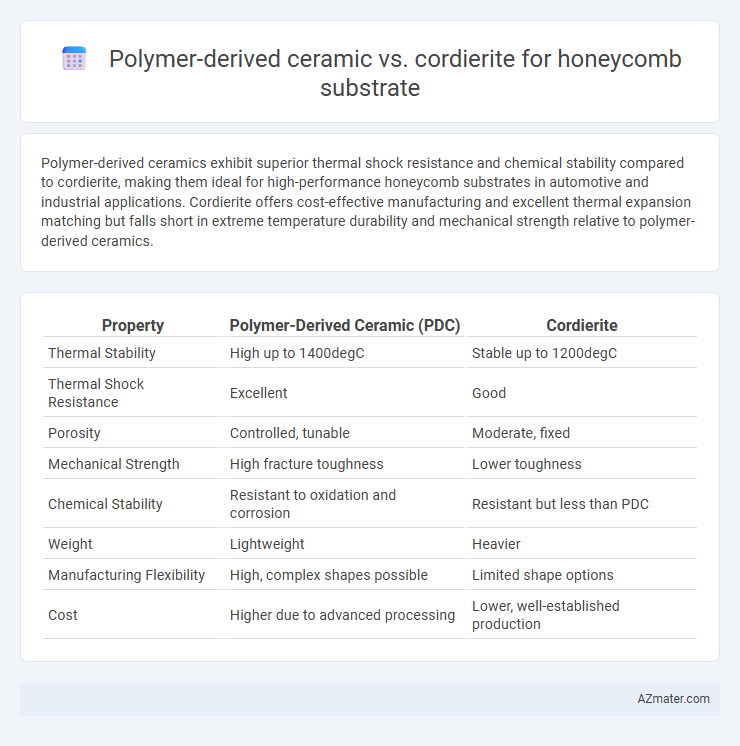Polymer-derived ceramics exhibit superior thermal shock resistance and chemical stability compared to cordierite, making them ideal for high-performance honeycomb substrates in automotive and industrial applications. Cordierite offers cost-effective manufacturing and excellent thermal expansion matching but falls short in extreme temperature durability and mechanical strength relative to polymer-derived ceramics.
Table of Comparison
| Property | Polymer-Derived Ceramic (PDC) | Cordierite |
|---|---|---|
| Thermal Stability | High up to 1400degC | Stable up to 1200degC |
| Thermal Shock Resistance | Excellent | Good |
| Porosity | Controlled, tunable | Moderate, fixed |
| Mechanical Strength | High fracture toughness | Lower toughness |
| Chemical Stability | Resistant to oxidation and corrosion | Resistant but less than PDC |
| Weight | Lightweight | Heavier |
| Manufacturing Flexibility | High, complex shapes possible | Limited shape options |
| Cost | Higher due to advanced processing | Lower, well-established production |
Introduction to Honeycomb Substrates in Industrial Applications
Honeycomb substrates are critical components in automotive and industrial catalytic converters due to their high surface area and low pressure drop characteristics. Polymer-derived ceramics offer superior thermal shock resistance and mechanical strength compared to traditional cordierite substrates, enhancing durability under harsh operating conditions. The advanced microstructure of polymer-derived ceramics enables improved catalytic efficiency and longer service life in exhaust treatment systems.
Overview of Polymer-derived Ceramics (PDC)
Polymer-derived ceramics (PDCs) are advanced materials synthesized by the pyrolysis of preceramic polymers, resulting in ceramics with superior thermal stability, chemical resistance, and mechanical strength compared to traditional cordierite substrates. PDC honeycomb substrates exhibit enhanced high-temperature durability and thermal shock resistance, making them ideal for demanding automotive and industrial catalytic converter applications. The tunable microstructure and lower thermal expansion coefficient of PDCs contribute to improved longevity and performance under harsh operating conditions.
Understanding Cordierite as a Honeycomb Substrate Material
Cordierite is a widely used honeycomb substrate material in automotive catalytic converters due to its excellent thermal shock resistance and low thermal expansion coefficient, which enhance durability under rapid temperature fluctuations. Its crystalline structure provides structural stability and efficient heat retention, contributing to improved catalyst performance and emission control. Compared to polymer-derived ceramics, cordierite offers a cost-effective solution with proven reliability in high-volume applications, although polymer-derived ceramics exhibit superior mechanical strength and higher temperature capability.
Structural Properties: Polymer-derived Ceramics vs Cordierite
Polymer-derived ceramics (PDCs) exhibit superior structural properties compared to cordierite for honeycomb substrates, featuring higher flexural strength and enhanced thermal shock resistance due to their dense microstructure and strong covalent bonding. Cordierite offers lower thermal expansion and good thermal stability but tends to have lower mechanical strength and fracture toughness. The inherent toughness and structural integrity of PDCs make them ideal for demanding applications requiring durability under high temperature and mechanical stress.
Thermal Stability and Resistance Comparison
Polymer-derived ceramics exhibit superior thermal stability compared to cordierite, maintaining structural integrity at temperatures exceeding 1400degC while cordierite typically degrades above 1200degC. The enhanced resistance of polymer-derived ceramics to thermal shock and oxidation makes them preferable for high-performance honeycomb substrates in automotive catalytic converters. Cordierite's lower thermal expansion coefficient offers moderate resistance but limits its application in extreme temperature environments, where polymer-derived ceramics excel.
Mechanical Strength and Durability Analysis
Polymer-derived ceramics (PDCs) exhibit superior mechanical strength and enhanced thermal shock resistance compared to cordierite, making them more durable under high-stress and high-temperature conditions typical in honeycomb substrate applications. Cordierite substrates possess lower fracture toughness and reduced mechanical strength, which can limit their lifespan in demanding environments where vibration and thermal cycling are prevalent. The intrinsic microstructure of PDCs contributes to better crack resistance and long-term stability, ensuring improved performance in catalytic converter and filtration systems.
Chemical Resistance: PDC vs Cordierite
Polymer-derived ceramics (PDC) exhibit superior chemical resistance compared to cordierite in honeycomb substrates, particularly in aggressive environments containing acids and alkalis. PDCs maintain structural integrity and resist corrosion at high temperatures due to their dense, non-porous microstructure, which limits chemical penetration. Cordierite substrates, while thermally stable, are more susceptible to chemical degradation and surface etching under prolonged exposure to acidic or basic exhaust gases.
Manufacturing Process and Cost Implications
Polymer-derived ceramics (PDCs) offer a flexible manufacturing process involving precursor pyrolysis and customizable shaping, enabling intricate honeycomb structures with high thermal stability, while cordierite substrates are produced through conventional extrusion and firing methods that are well-established but limited in geometric complexity. The PDC process typically incurs higher initial costs due to specialized materials and pyrolysis equipment but can lead to cost savings in high-performance applications through enhanced durability and reduced weight. Cordierite remains cost-effective for mass production with lower raw material expenses and scalable manufacturing, making it suitable for standard catalytic converter substrates.
Performance in Catalytic Converter Applications
Polymer-derived ceramics offer superior thermal stability and higher fracture toughness compared to cordierite, enhancing the durability of honeycomb substrates in catalytic converter applications. Their ability to withstand rapid temperature fluctuations reduces thermal shock risks, leading to prolonged substrate lifespan under harsh exhaust conditions. Cordierite substrates, while cost-effective and widely used, demonstrate lower thermal conductivity and are more prone to cracking under high thermal stress.
Conclusion: Choosing Between Polymer-derived Ceramics and Cordierite for Honeycomb Substrates
Polymer-derived ceramics offer superior thermal stability, higher mechanical strength, and enhanced resistance to thermal shock compared to cordierite, making them ideal for demanding honeycomb substrate applications. Cordierite remains a cost-effective choice with excellent thermal expansion matching and good chemical resistance, suitable for less severe operating conditions. Selecting between these materials depends on balancing performance requirements with budget constraints and specific operational environment factors.

Infographic: Polymer-derived ceramic vs Cordierite for Honeycomb substrate
 azmater.com
azmater.com